Post-World War II anti-fascism
Anti-fascist movements (/ˈæntifɑː, ænˈtiːfə/)[1] and anti-fascist action networks are groups that describe themselves as anti-fascist. Such movements have been active in several countries in the second half of the 20th and early 21st century.
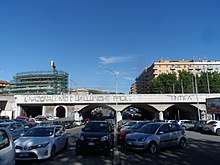
History
Europe
Germany
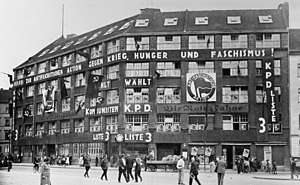
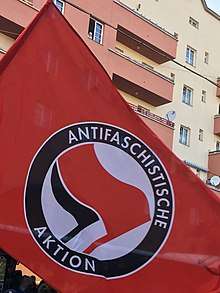
According to German government institutions the Federal Office for the Protection of the Constitution and the Federal Agency for Civic Education, the contemporary Antifa or anti-fascist movement in Germany—the terms are often used interchangeably in German[2]—is composed of multiple far-left, autonomous, militant groups and individuals who describe themselves as anti-fascist. The use of the epithet fascist against opponents and the understanding of capitalism as a form of fascism are central to the movement.[3][2] According to political scientist and Christian Democratic Union politician Tim Peters, the term anti-fascism is primarily used by the far left in contemporary Germany.[4]
In West Germany there was anger among leftist youth at the perceived failure of the post-war denazification due that government positions were often occupied by ex-Nazis.[5][6] German President Walter Scheel and Chancellor Kurt Georg Kiesinger were both former members of the Nazi Party. In 1950, a major controversy broke out when it emerged that Konrad Adenauer's State Secretary Hans Globke had played a major role in drafting anti-semitic Nuremberg Race Laws in Nazi Germany.[7] Despite the failure of the student movement a change in political consciousness lasted throughout the country. Criticisms of West German officials' ties to the old Nazi Party brought the concept of Vergangenheitsbewältigung (coming to terms with the past) to the forefront of political discussion. Other various left-wing causes also gained popularity and helped solidify a protest culture in Germany.[8] Rudi Dutschke was a student activist in the growing student protests. On April 11, 1968 he was shot by the far-right Joseph Bachmann. Dutschke was injured but survived the shooting. The attempted assassination of Dutschke would be later regarded as the formal beginning of the West German student movement.[9] According to German government institutions, the modern movement has its roots in the West German Außerparlamentarische Opposition left-wing student movement during the 1960s and 1970s and largely adopted the aesthetics of the Antifaschistische Aktion during the late Weimar Republic, including the abbreviated name Antifa and a version of its logo, while being ideologically somewhat dissimilar. The first Antifa groups in this tradition were founded by the Maoist Communist League in the early 1970s. From the late 1980s, West Germany's squatter scene and left-wing autonomism movement were the main contributors to the new Antifa movement and in contrast to the earlier movement had a more anarcho-communist leaning. The modern movement has splintered into different groups and factions, including one anti-imperialist and anti-Zionist faction and one anti-German faction who strongly oppose each other. German government institutions describe the contemporary Antifa movement as part of the extreme left and as partially violent, and Antifa groups are monitored by the federal office in the context of its legal mandate to combat extremism;[2][10][3][11] the federal office states that the underlying goal of the Antifa movement is "the struggle against the liberal democratic basic order" and capitalism.[3][2]
Sweden: Antifascistisk Aktion activities
Militant anti-fascism emerged in Sweden in the early 1990s, in particular around the yearly November 30 protests in Lund and Stockholm propelled by blockades of neo-nazi marches in both cities in 1991.[12] The main militant antifascist group in the country was the Antifascistisk Aktion (AFA), founded in Sweden in 1993 with as many as 20 branches in the late 1990s. It was inspired by a group with the same name that had started in Copenhagen in 1991 and British groups with similar names from the 1980s. The early tactics mainly focused on large demonstrations, in particular blockades of marches inspired by the 30th November events in Lund between 1991 and 1993. In parts of Sweden where these actions were less anchored in memory culture, a more territorial repertoire of interpersonal violence instead dominated, particular in the late 1990s.[13] It was in this period that AFA published a detailed Activity Guide describing tactical uses of violence against neo-Nazis. In the early 2000s Antifascist Action split, with the now defunct, more Marxist and Workerkist Revolutionära Fronten (The Revolutionary Front) forming out of remnants of its Gothenburg, Stockholm and Örebro branches. Since the late 2000s the type of militant street-based antifascism that AFA and Revolutionära Fronten represented has declined, in response to a more parliamentarian and online focus in the far right. This is evident by the very limited public role in many of the largest antifascist demonstrations in the 2010s, including the large 2018 Gothenburg blockade of the Nordic Resistance Movement, the massive Kärrtorp protest, and the massive 13.000 person strong demonstration in 2014 in response to the stabbing of Showan Shattak and three other antifascists in Malmö.[14]
United Kingdom: against the NF and BNP
After World War II, Jewish war veterans in the 43 Group continued the tradition of militant confrontations with Oswald Mosley's Union Movement. In the 1960s, the 62 Group continued the struggle against neo-Nazis.[15]
In the 1970s, fascist and far-right parties such as the National Front (NF) and British Movement (BM) were making significant gains electorally, and were increasingly bold in their public appearances. This was challenged in 1977 with the Battle of Lewisham, when thousands of people disrupted an NF march in South London.[16] Soon after, the Anti-Nazi League (ANL) was launched by the Socialist Workers Party (SWP). The ANL had a large-scale propaganda campaign and squads that attacked NF meetings and paper sales. The success of the ANL's campaigns contributed to the end of the NF's period of growth. During this period, there were also a number of black-led anti-fascist organizations, including the Campaign Against Racism and Fascism (CARF) and local groups like the Newham Monitoring Project.[17]
The SWP disbanded the ANL in 1981, but many squad members refused to stop their activities. They were expelled from the SWP in 1981, many going on to found Red Action. The SWP used the term squadism to dismiss these militant anti-fascists as thugs. In 1985, some members of Red Action and the anarcho-syndicalist Direct Action Movement launched Anti-Fascist Action (AFA). Their founding document said "we are not fighting Fascism to maintain the status quo but to defend the interests of the working class".[18][19] Thousands of people took part in AFA mobilizations, such as Remembrance Day demonstrations in 1986 and 1987, the Unity Carnival, the Battle of Cable Street's 55th anniversary march in 1991, and the Battle of Waterloo against Blood and Honour in 1992.[20] After 1995, some AFA mobilizations still occurred, such as against the NF in Dover in 1997 and 1998. However, AFA wound down its national organization and some of its branches and had ceased to exist nationally by 2001.[21]
There was a surge in fascist activity across Europe from 1989 to 1991 after the collapse of Communism. In 1991, the Campaign Against Fascism in Europe (CAFE) coordinated a large militant protest against the visit to London by French right-wing leader, Jean-Marie Le Pen. This sparked a surge in anti-fascist organizations throughout Europe. In the UK alone, in 1992 a number of left-wing groups formed anti-fascist front organizations, such as a re-launched ANL in 1992, the Socialist Party's Youth against Racism in Europe YRE, and the Revolutionary Communist Party's Workers Against Racism. A number of black-led organizations, along with the Labour Party Black Sections and the National Black Caucus, formed the Anti-Racist Alliance in 1991, which eventually became the National Assembly Against Racism.[22]
In August 2018, the Shadow Chancellor John McDonnell called for a revival of "an Anti-Nazi League-type cultural and political campaign" following a number of far-right and racist incidents in the UK, including fascist attacks on a socialist bookshop by members of the far-right and UKIP, marches in favor of far-right activist Tommy Robinson and high-profile Islamophobia in the Conservative Party.[23][24] This "welcome and timely" call to action was supported in a Guardian letter signed by the league's founders, which included former Labour minister Peter Hain, political activist Paul Holborow and leading musicians from Rock Against Racism.[24]
Asia
Japan
In 2013, when Counter-Racist Action Collective (C.R.A.C.), which had been counter-acting against the conservative group Zaitokukai, began to denounce Prime Minister Shinzo Abe as a "fascist," groups calling themselves "Antifa" appeared around them. In addition to Tokyo, Antifa also have appeared in Hokkaido, Shizuoka, Aichi, and Hiroshima prefectures.[25] They then promoted the Democratic Party's presidential election and participated in "Abe Out" demonstrations with liberals and opposition members of the Japanese Communist Party and the Constitutional Democratic Party of Japan.[26][27][28]
In 2020, the activities of Antifa increased. In February, those waving the flag of Antifa were identified among those who were counter-acting against Zaitokukai.[25] In May, Antifa also participated in the protest against the Abe Cabinet's coronavirus measures. In the protest, a foreign man was holding the Antifa flag, which was written in German as "ANTIFASCHISTSCHE AKTION."[25] On May 17, Antifa was among the organizers of a nationwide protest against the revision of the Public prosecutor's office Law.[25] When George Floyd protests occurred in the U.S. at the end of May, protest of "Black Lives Matter" were held in Tokyo and Osaka in June, and Antifa was also seen.[25] On May 30 and June 6, Antifa and others led the protest against the hate crime by the police around the Shibuya Police Department.[29][30] George Floyd protests were also held at the same time, and many foreigners and opposition members of the Diet also participated in the protests[26][31]. Antifa's flag was raised, and there were arrests in the fight.[25][32][33] The incident began when a Kurdish man in Japan claimed to have been unfairly questioned by Metropolitan Police officers and subjected to violence. Mainichi Shimbun and Kyodo News reported this as a hate crime though the Metropolitan Police denied.[29][30][32][33][34] On June 10, the General Information Center for Foreign Residents of immigration bureaus across Japan received a "bomb threat" e-mail from a person claiming to be "Antifa" targeting the Immigration Bureau and the Shibuya Police Department for abusing foreigners.[25][35][36][37] However, on June 13, the Japanese Kurdish Cultural Association, which consists of Kurds, expressed a negative view of the protest claims on their official Facebook page. The association declared that they did not support the protest and did not take any part in it, and abandoned the said person, saying there was no room to defend his actions in light of Japanese laws and customs.[32][33][38] And the association announced that the demonstrators were not all involved in their usual protests against the crackdown on the Kurds or in their support activities.[32][33][38] They said that a less-than-justified demonstration like this seems to have encouraged prejudice against Kurdish residents in Japan. They also said it's strange that no Japanese major media have covered them at all on this matter.[32][33][38]
United States
After World War II, but prior to the development of the modern antifa movement, violent confrontations with Fascist elements happened sporadically in the United States. In 1958 over 500 Lumbee men armed with rocks, sticks and firearms attacked and disrupted a Ku Klux Klan rally, wounding several Klansmen in an event known as the Battle of Hayes Pond. In 1979 the Maoist Communist Workers' Party confronted a local Ku Klux Klan chapter, first by disrupting a screening of The Birth of a Nation in China Grove, North Carolina and later organizing a rally and a march against the Klan on November 3 called the "Death to the Klan March" by the CWP.[39] The Maoists distributed flyers that "called for radical, even violent opposition to the Klan",[39] suggesting the Klan “should be physically beaten and chased out of town."[39] In response, as the marchers collected, a caravan of ten cars (and a van) filled with an estimated 40 KKK and American Nazi Party members confronted the protesters, culminating in a shootout known as the Greensboro Massacre.
In the 2010s, self-described antifa groups have become increasingly active in Western Europe and North America.[40] These loose collectives first arose in the early 2010s in response to growing nationalism in countries including the United States, United Kingdom, Denmark, Germany, and France.[41][42][43] In the US, anti-fascist groups had existed since at least 1988 in the form of the Anti-Racist Action,[44] but an American movement using the same name has become increasingly active since 2016,[45][46] often affiliated with anarchism, and have become known for their clashes with far-right and alt-right groups.[44][47][48] US anti-fascist activities have included violent disruptions and demonstrations which have drawn criticism from both sides of the mainstream political spectrum.[40][43][49] Through their anarchist and anti-nationalist orientation, antifa groups have sometimes been linked to the punk subculture (including straight edge) both in the US and in Europe.[50]
Syrian Civil War
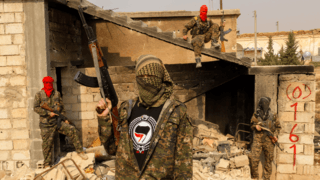
Hundreds of foreign Antifa leftists have joined the International Freedom Battalion (founded in 2015) of the People's Protection Units (YPG) in the region called Rojava by kurd militias, in the North and East of Syria, out of a mixture of opposition to the Islamic State during the Syrian Civil War and willingness to defend what they call «Rojava Revolution» against the Syrian Arab Republic.[51][52]
Gallery
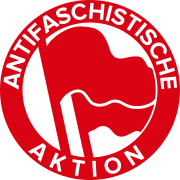 Logo of Antifaschistische Aktion (1930s; Germany)
Logo of Antifaschistische Aktion (1930s; Germany)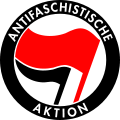 Logo of Antifaschistische Aktion (Germany)
Logo of Antifaschistische Aktion (Germany) Toilet brush symbol adopted for the Hamburg protests of the German Antifa, 2014
Toilet brush symbol adopted for the Hamburg protests of the German Antifa, 2014.svg.png) Logo of Antifascistische Aktie (Netherlands)
Logo of Antifascistische Aktie (Netherlands)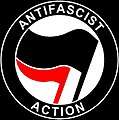 Antifascist Action logo seen in US
Antifascist Action logo seen in US- Logo of Sicilia Antifascista (Sicily)
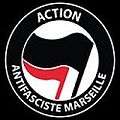 Logo of Action Antifasciste Marseille (Marseille)
Logo of Action Antifasciste Marseille (Marseille) Logo of Union Antifasciste Toulousaine (Toulouse)
Logo of Union Antifasciste Toulousaine (Toulouse)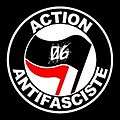 Logo of Action Antifasciste 06 (France)
Logo of Action Antifasciste 06 (France)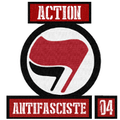 Logo of Action Antifasciste 04 (France)
Logo of Action Antifasciste 04 (France) Logo of Antifascistisk Aksjon (Norway)
Logo of Antifascistisk Aksjon (Norway) Logo of Antifa London (London)
Logo of Antifa London (London) Logo of Acción Antifascista (Spain)
Logo of Acción Antifascista (Spain)
See also
References
- "Language Log » Ask Language Log: How to pronounce "Antifa"?". languagelog.ldc.upenn.edu. Retrieved September 23, 2017.
- Linksextremismus: Erscheinungsformen und Gefährdungspotenziale [Far-left extremism: Manifestations and danger potential] (PDF). Federal Office for the Protection of the Constitution. 2016. pp. 33–35. Archived from the original (PDF) on 2020-06-02.
Die Aktivitäten „antifaschistischer“ Linksextremisten (Antifa) dienen indes nur vordergründig der Bekämpfung rechtsextremistischer Bestrebungen. Eigentliches Ziel bleibt der „bürgerlich-demokratische Staat“, der in der Lesart von Linksextremisten den „Faschismus“ als eine mögliche Herrschaftsform akzeptiert, fördert und ihn deshalb auch nicht ausreichend bekämpft. Letztlich, so wird argumentiert, wurzle der „Faschismus“ in den gesellschaftlichen und politischen Strukturen des „Kapitalismus“. Dementsprechend rücken Linksextremisten vor allem die Beseitigung des „kapitalistischen Systems“ in den Mittelpunkt ihrer „antifaschistischen“ Aktivitäten.
- "Aktionsfeld 'Antifaschismus'" [The field of "anti-fascism"]. Federal Office for the Protection of the Constitution. Archived from the original on 2020-05-15. Retrieved 2019-07-29.
Das Aktionsfeld „Antifaschismus“ ist seit Jahren ein zentrales Element der politischen Arbeit von Linksextremisten, insbesondere aus dem gewaltorientierten Spektrum. [...] Die Aktivitäten von Linksextremisten in diesem Aktionsfeld zielen aber nur vordergründig auf die Bekämpfung rechtsextremistischer Bestrebungen. Im eigentlichen Fokus steht der Kampf gegen die freiheitliche demokratische Grundordnung, die als „kapitalistisches System“ diffamiert wird, und deren angeblich immanente „faschistische“ Wurzeln beseitigt werden sollen.
- Peters, Tim (2007). Der Antifaschismus der PDS aus antiextremistischer Sicht [The antifascism of the PDS from an anti-extremist perspective]. Springer. pp. 33–37, 152, 186. ISBN 9783531901268.
- Steigerwald, David; Albarran, Elena; Davidson, John (May 4, 2018). "Time It Was: 1968 Around the World". origins.osu.edu. Retrieved 21 May 2020.
- Center for History, "Allianz in the Years 1933–1945 – Limits of denazification" Archived 6 May 2009 at the Wayback Machine; Lord Paddy Ashdown, "Winning the Peace" Archived 8 August 2007 at the Wayback Machine, BBC World Service Website.
- Tetens, T.H. The New Germany and the Old Nazis, New York: Random House, 1961 pages 37–40.
- Dilley, Ana (July 16, 2019). "Explained: What sparked the protest culture of modern Germany?". thelocal.de.
- Mund, Heike (May 4, 2018). "1968: The year of cultural revolution in postwar Germany". dw.com.
- "Linksextremismus" [Far-left extremism]. Verfassungsschutzbericht 2018 (PDF). Federal Ministry of the Interior, Building and Community. 2019. pp. 106–167.
- Pfahl-Traughber, Armin (6 March 2008). "Antifaschismus als Thema linksextremistischer Agitation, Bündnispolitik und Ideologie" [Anti-fascism as a topic of far-left extremist agitation, political alliances and ideology]. Federal Agency for Civic Education.
- Brink Pinto, Andrés; Pries, Johan (2017). Wennerhag, Magnus; Fröhlich, Christian; Piotrowski], Grzegorz (eds.). Rethinking transformative events to understand the making of new contentious performances: The “autonomous left” and the anti-fascist blockade in Lund 1991. Routledge.
- Brink Pinto, Andrés; Pries, Johan (2019). "Challenging fascist spatial claims: the struggle over the 30 November marches in southern Sweden". In Lundin, Johan (ed.). Anti-fascism in the Nordic Countries: New Perspectives, Compasrisons and Transnational Connection,. Routledge.
- Merill, Samuel; Pries, Johan (2019). "Translocalising and Relocalising Antifascist Struggles: From #KämpaShowan to #KämpaMalmö". Antipode. 51 (1).
- Prowe, Diethelm (November 1994). "'Classic' Fascism and the New Radical Right in Western Europe: Comparisons and Contrasts". Contemporary European History. 3 (3): 289–313. doi:10.1017/S0960777300000904. JSTOR 20081528.
- "The real losers in Saturday's battle of Lewisham | 1970–1979". century.guardian.co.uk. Retrieved 7 April 2014.
- "NMP’s History of Resisting Racism and Injustice"; Alastair BonnettRadicalism, Anti-Racism and Representation, London: Routledge, 2013, p. 57; Nigel Copsey Anti-Fascism in Britain, Springer, 1999, pp. 125–183
- "Anti-Fascist Action: Radical resistance or rent-a-mob?" (PDF). Soundings – issue 14 Spring 2000. Amielandmelburn.org.uk.
- AFA (London) Constitution Part 1.4
- "Diamond in the Dust – The Ian Stuart Biography". Skrewdriver.net. Archived from the original on 27 April 2009. Retrieved 7 April 2014.
- Nigel Copsey (2016). Anti-Fascism in Britain London: Routledge,
- Peter Barberis, John McHugh, Mike Tyldesley (2005). Encyclopedia of British and Irish Political Organizations: Parties, Groups and Movements of the 20th Century. Continuum International Publishing Group. p. 107. ISBN 978-0-8264-5814-8; Stefano Fella, Carlo Ruzza (2012). Anti-Racist Movements in the EU: Between Europeanisation and National Trajectories. Palgrave Macmillan. ISBN 978-0-230-29090-7, pp. 67–68
- Sabbagh, Dan (7 August 2018). "John McDonnell: revive Anti-Nazi League to oppose far right". The Guardian. Retrieved 20 August 2018.
- Sabbagh, Dan (15 August 2018). "Anti-Nazi League founders call for new national campaign". The Guardian. Retrieved 20 August 2018.
- "各地で姿を現す日本版「アンティファ」の実態に迫る 公安警察も警戒強めだした新たなる極左行動集団の活動" [Approaching the reality of the Japanese version of "Antifa" that appears in various places - New extreme left action group activities which the public security police also increase a sense of vigilance]. Japan Business Press (in Japanese). June 16, 2020. Retrieved 18 June 2020.
- "ジャーナリスト・石井氏「議員がテロ集団と名指しされたアンティファと深く関わる日本共産党と立憲民主党、それを報道しないメディアを持つ日本は何なんでしょうか」" [Journalist Ishii "What is Japan that has the Japanese Communist Party and the Constitutional Democratic Party of Japan, whose members are deeply involved with Antifa who was named a terrorist group, and media that does not report it?"]. Share News Japan (in Japanese). June 2, 2020. Retrieved 18 June 2020.
- "怒りは限界に達した 名古屋で「安倍は辞めろ」デモ" [Anger reached the limit "Abe out" Demonstration in Nagoya]. Japanese Communist Party Aichi Committee Official site (in Japanese). January 13, 2020. Retrieved 18 June 2020.
- "路上から安倍政治に怒り" [Anger at Abe's politics from the streets]. Shimbun Akahata (in Japanese). Japanese Communist Party. January 21, 2019. Retrieved 18 June 2020.
- "「警官に押さえ込まれけが」 渋谷署前で200人が抗議デモ クルド人訴えに共鳴" ["He was held down by a policeman and injured." 200 people protest in front of Shibuya station - Resonant with Kurdish complaints]. Mainichi Shimbun (in Japanese). May 30, 2020. Retrieved 18 June 2020.
- "警視庁渋谷署前で再び抗議デモ 職務質問でクルド人男性がけが" [Another protest in front of the Shibuya police station of the Metropolitan Police Department Kurdish men hurt by police question]. Mainichi Shimbun (in Japanese). June 6, 2020. Retrieved 18 June 2020.
- "渋谷署前のデモ、立憲・石川大我議員の後ろに米大統領がテロ組織と認めた『ANTIFA』の旗 → 石川議員、ツイート削除…" [The protest in front of the Shibuya police station, behind the Constitutional Democratic Party of Japan, Ishikawa Daiga, there is a flag of "ANTIFA" that the President of the US recognized as a terrorist organization.→Ishikawa deleted the tweet...]. Share News Japan (in Japanese). June 1, 2020. Retrieved 18 June 2020.
- "在日クルド人ヘイトクライム抗議デモに在日クルド協会が関与否定の異例声明" [Unusual statement by the Kurdish Association of Japan denying its involvement in the Kurdish hate crime protest in Japan]. Business Journal (in Japanese). June 15, 2020. Retrieved 18 June 2020.
- "警察への抗議デモは「偏見を助長した」 在日クルド人団体「苦言」の背景" [The protest against the police "promoted prejudice" Background of "complaints" by Kurdish groups in Japan]. J cast (in Japanese). June 15, 2020. Retrieved 18 June 2020.
- "渋谷で「警察は人種差別するな」 500人抗議、クルド人職質にも" ["Police should not be racist" 500 people protest in Shibuya, police check-up to Kurdish]. Kyodo News (in Japanese). Tokyo Shimbun. June 6, 2020. Retrieved 18 June 2020.
- "「手榴弾爆破させる」 渋谷署などに予告メール クルド人男性への職務質問などに抗議か" ["Explode a grenade" The Shibuya police and others received a bomb scare email ─ Protest against a police checkup on a Kurdish man?]. Sankei Shimbun (in Japanese). June 11, 2020. Retrieved 18 June 2020.
- "東京入管に爆破予告のメール 12日の窓口業務が中止に" [Tokyo Immigration Bureau had a bomb scare email arrive]. NHK (in Japanese). 11 Jun 2020. Retrieved 18 June 2020.
- "東京入国管理局に爆破予告メールが届く" [Tokyo Immigration Bureau received a bomb threat email]. Arab News Japan (in Japanese). 12 Jun 2020. Retrieved 18 June 2020.
- "渋谷警察署デモに関して日本クルド文化協会が見解発表「正当な理由があるとは言い難いデモ」" [Japan Kurdish Cultural Association announces its opinion on the Shibuya police station demonstration "It is hard to say that there is a valid reason"]. ガジェット通信 (in Japanese). June 15, 2020. Retrieved 19 June 2020.
- "The Greensboro Massacre". University of North Carolina – Greensboro. Retrieved 2014-02-02.
- Stockman, Farah (2 Feb 2017). "Anarchists Respond to Trump's Inauguration, by Any Means Necessary". New York Times. Retrieved 10 July 2017.
- Copsey, Nigel (2017). Anti-Fascism in Britain. Abingdon, UK: Routledge. p. 210. ISBN 9781138926493.
- Horn, Heather (29 March 2012). "Anti-Islamic vs. Anti-Fascist: Europe's Clashing Protest Movements". The Atlantic. Retrieved 10 July 2017.
- Yates, Will (20 February 2017). "America's extremist battle: antifa v alt-right". BBC News. Retrieved 22 February 2017.
- Strickland, Patrick (21 February 2017). "US anti-fascists: 'We can make racists afraid again'". Aljazeera. Retrieved 10 July 2017.
- Beinhart, Peter. "The Rise of the Violent Left". The Atlantic. Retrieved 12 August 2017.
- "Behind Berkeley's Semester of Hate". New York Times. 4 August 2017. Retrieved 12 August 2017.
- "UK police arrest 12 at London protest, block clashes". Business Insider. 1 April 2017. Retrieved 10 July 2017.
- Osborne, Samuel (25 June 2017). "EDL and anti-fascists clash with police in London". Independent. Retrieved 10 July 2017.
- Sheffield, Matthews (10 March 2017). "Anti-fascist radicals: Liberals don't realize the serious danger of the alt-right". Salon. Retrieved 10 July 2017.
- Kuhn, Gabriel (2010). Sober Living for the Revolution: Hardcore Punk, Straight Edge, and Radical Politics. PM Press. p. 137. ISBN 1604860510. Retrieved 7 October 2017.
- "Interview with YPG Commander Cihan Kendal". 19 September 2019. (2016)
- The Untold Story of Syria's Antifa Platoon. How a ragtag crew of leftist revolutionaries and soldiers of fortune helped defeat ISIS. Rolling Stone (2018)

